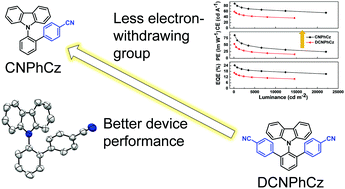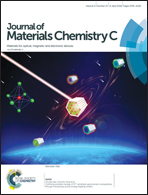Novel carbazole derivatives designed by an ortho-linkage strategy for efficient phosphorescent organic light-emitting diodes†
Abstract
Two novel carbazole derivatives 2′-(9H-carbazol-9-yl)-[1,1′-biphenyl]-4-carbonitrile (CNPhCz) and 2′-(9H-carbazol-9-yl)-[1,1′:3′,1′′-terphenyl]-4,4′′-dicarbonitrile (DCNPhCz) were designed and prepared as host materials for phosphorescent organic light-emitting diodes (PHOLEDs). CNPhCz and DCNPhCz were synthesized by an ortho-linkage strategy. In CNPhCz, one cyanophenyl and one carbazole unit were attached to the central benzene ring at the neighboring positions, while in DCNPhCz the carbazole group was surrounded by two cyanophenyl groups. The influence of different numbers of electron-withdrawing groups in these host materials on the charge-transport behavior and OLED device performance was studied systematically. Blue and green PHOLEDs based on these hosts were fabricated using common device structures with bis(4,6-(difluorophenyl)pyridinato-N,C2′)picolinate iridium(III) (FIrpic) and bis(2-phenylpyridine) (acetylacetonate)iridium(III) (Ir(ppy)2(acac)) as the dopants, respectively. The results indicated that the material with a smaller number of electron-withdrawing cyanobenzene groups (CNPhCz) showed better green PHOLED device performance with maximum efficiencies of 88.0 cd A−1, 86.1 lm W−1 and 24.4%.



 Please wait while we load your content...
Please wait while we load your content...